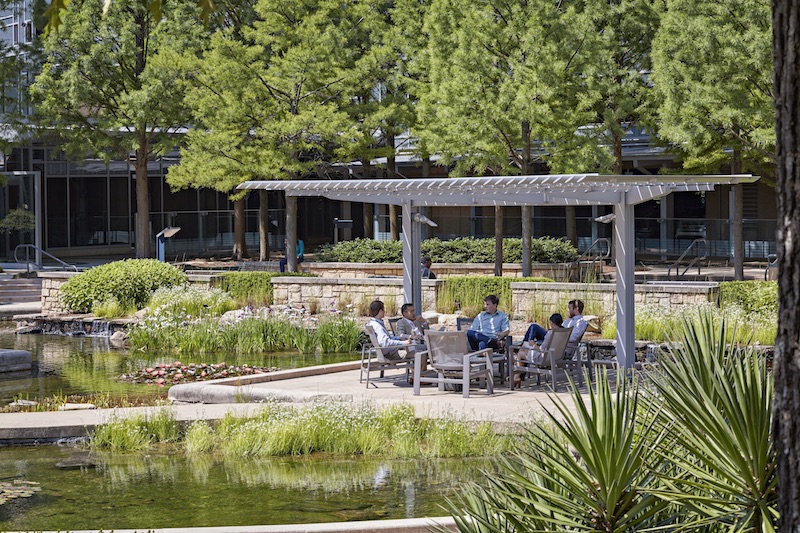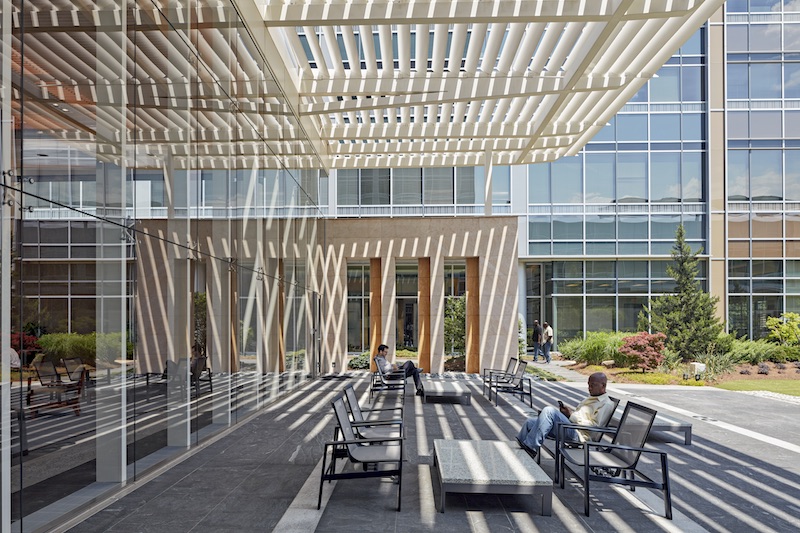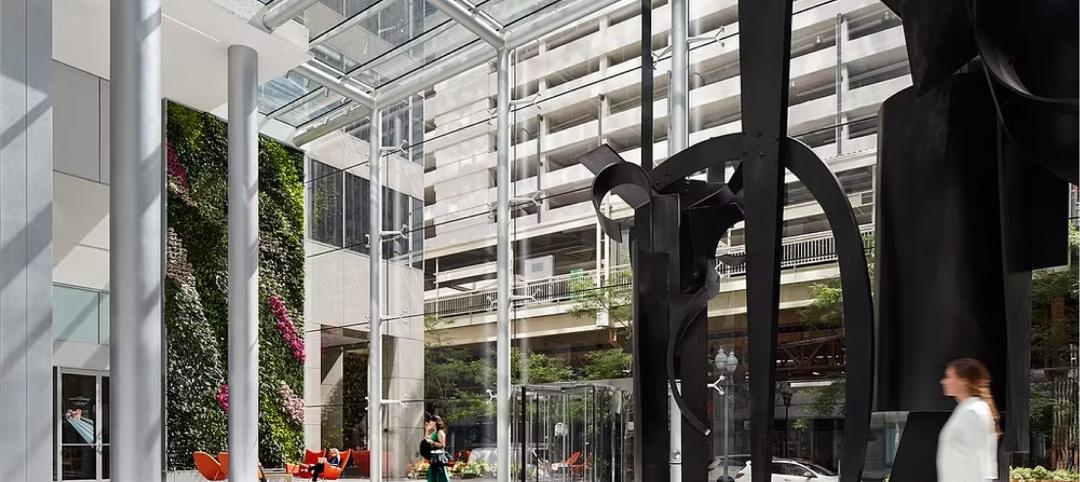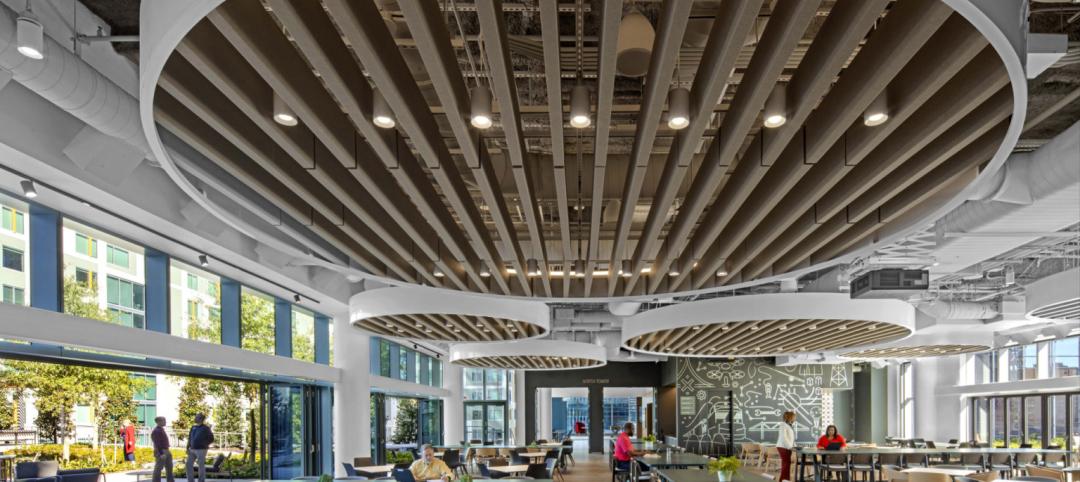A generational shift and advances in technology are changing the work environment. Corporate America seeks to draw young workers who, rather than swinging hammers, wield mobile devices to generate ideas and produce results. Today’s college graduates have experienced an environment with more amenities than ever before, and with them comes new expectations about the workplace: “I'm going to work the way I want. I'm going to come up with an idea with my buddies at Starbucks and revolutionize the things." This is the new and pervasive culture that is redefining corporate architecture.
Much has been written about the Millennial generation. Their emergence into the working world comes with a sense of openness for all. Thus, the challenge is more than designing building and spaces to attract, inspire and retain one micro-generation. Today’s workplace requires designers and employers to look holistically at the organization’s culture, its criteria for success, and its place in the world. Shaping an effective workplace is about more than rethinking its architecture. Designers must push beyond the idea of ‘this is the way we do it here’ and drill down to the intentions and vision for that specific business.
Out-of-the-Cubicle
Technology has altered the work process, and in many ways its product, but the rules of workplace engagement have changed too. What is today’s expectation of how we should work? Not long ago, an employee was given a task and went to their office or cubicle to accomplish it. The employee with their ‘nose to the grindstone’ was the ideal. Today’s model says, "Yes, an employee sits in that spot, but also makes impactful contact with others." At McKinney, an advertising firm in Durham, creative directors have the smallest offices and aren’t expected to be in their office until after 5 o'clock; they're expected to be out talking to their teams.
The push for mobility and flexibility is not tied to any one generation or corporate level. Now, even CEOs are taking their laptops and smartphones to Starbucks in search of a different type of space. People crave the freedom to move around, within, and beyond a designated space. Many clients still want private offices, but they’re also looking for areas to collaborate and varied meeting spaces. Some companies are reducing office size because they want employees out in the organization or the community, not behind a desk.
With more than just a nod to office redesign, companies are relocating from the suburban areas to more central locations near public transportation and amenities. These metro locations place them closer to the people they want to hire and retain—an exciting, urban minded, and creative new workforce. But this trend is about more than just convenience: a 2015 survey of Millennials found 77% choose a workplace based partly on whether the company has “a sense of purpose,” and revitalizing neglected urban centers is considered both green and socially responsible. The trend toward urbanization is an environmental plus, because city dwellers drive less, live in spaces that use less energy, and require fewer resources than their suburban counterparts.
 Courtesy Robert Benson Photography.
Courtesy Robert Benson Photography.
Creativity’s Stock is Up
Creativity in the workplace is no longer an option. On the heels of successful enterprises such as Apple and Google, fostering creativity expands an organization’s potential. More traditional corporate cultures—law firms, sales organizations, and service companies—have made significant advancements in valuing creativity. But how is creativity added to a culture that never had it before? Simply adding a new collaboration or creative space and assuming staff, who come from a traditional work world, will change their behavior is a fallacy and can cause skepticism.
Reflecting and facilitating creativity in the workplace means allowing for flexibility and different working styles, and both aid in accommodating all levels of diversity. Space for moving around, getting out of an individual workspace and talking as a group, and collaborating with multiple team members requires different types of spaces and furnishing. The Dilbert-type cubicle is the antithesis of creativity. Take away the cubicle and people are suddenly in the same room together. Then, it's not just fulfilling a task— the individual is in a place where the metrics are group oriented. This is where creativity kicks in, and that's how the business world is transforming. Most architectural and design firms utilize open studios for exactly this reason.
Open, flexible space is advantageous for organizations, which can function like a workplace laboratory, modifying and adapting to changing needs. For example, rather than just adding conference rooms, multifunction spaces simply do more: roof terraces, café, breakout, and meditation areas allow equally for meetings, conferencing, and individual focus. GlaxoSmithKline recently put ‘phone rooms’ into their offices, so employees have a private place to use their cellphones. And they aren’t alone as companies as diverse as Slate Magazine as well as laboratories and construction companies make way for a variety of diverse, flexible spaces.
 Courtesy Duda|Paine Architects.
Courtesy Duda|Paine Architects.
Architecture and HR
Today, mobility and flexibility free staff to work where, when, and how they want, but that freedom has eroded our sense of where work stops. ‘Office hours’ can mean 24/7 with the technology created in just one generation. Employees must become stewards of their own work/life balance. In response, companies are thinking more holistically and asking architecture to project this new attitude.
Shaping the right office environment is an investment and a company’s best recruiting tool. At Cox Headquarters, a prospective recruit is typically convinced after a tour of the amenity rich campus, which in addition to a gym and café options, includes landscaped gardens. Cox’s goal is to do more than recruit great employees, it's retention.
The new generation employee also cares more about health and is infinitely more informed on the topic than previous generations. With their professional expectations and spatial needs shaped by experiences in education, they see the balance between good health and good work as essential. Connecting a work environment more directly to the outdoors, as Cox has done, is one approach.
Making Work Visible
An e-blast might not be the best way to showcase an organization’s work. More and more organizations are looking to gallery spaces and ‘innovation halls’ to showcase what they do to the public, future recruits, and staff. The idea of being able to see what people in a company are working on opens everyone to being informed and inspired. At the award-winning John Deere Moline headquarters, Eero Saarinen and Kevin Roche made a conscious decision for staff members to enter the headquarters building through a two-story museum, which includes a 3-dimensional mural of the company’s history, as well as vintage and new tractors, bulldozers, and other equipment. Thus, whether an employee balances the books, works in HR, or designs machinery, they experience firsthand what John Deere is all about.
Stop Blaming Millennials!
The new office environment—diverse, flexible, highly accommodating and highly functional—transcends generation. Its advanced technology, mobile-readiness, openness and variety of spaces speak to how all of us, not just today’s graduates, want to work and be successful today.
 Courtesy Robert Benson Photography.
Courtesy Robert Benson Photography.
Related Stories
Mixed-Use | Jun 1, 2023
The Moore Building, a 16-story office and retail development, opens in Nashville’s Music Row district
Named after Elvis Presley’s onetime guitarist, The Moore Building, a 16-story office building with ground-floor retail space, has opened in Nashville’s Music Row district. Developed by Portman and Creed Investment Company and designed by Gresham Smith, The Moore Building offers 236,000 sf of office space and 8,500 sf of ground-floor retail.
Office Buildings | May 24, 2023
The future of work: What to expect in 2023
While no one disagrees that the workplace has undergone tectonic changes, it is less clear how to understand these shifts and synthesize them into practical action for the coming year.
Multifamily Housing | May 23, 2023
One out of three office buildings in largest U.S. cities are suitable for residential conversion
Roughly one in three office buildings in the largest U.S. cities are well suited to be converted to multifamily residential properties, according to a study by global real estate firm Avison Young. Some 6,206 buildings across 10 U.S. cities present viable opportunities for conversion to residential use.
Headquarters | May 16, 2023
Workplace HQ for party clothing company Shinesty celebrates its bold, whimsical products
The new Denver headquarters for Shinesty, a party clothing company, was designed to match the brand’s fun image with an iconic array of colors, textures, and prints curated by the design agency, Maximalist. Shinesty’s mission, to challenge the world to live more freely and “take itself less seriously,” is embodied throughout the office interior.
Office Buildings | May 15, 2023
Sixteen-story office tower will use 40% less energy than an average NYC office building
This month marks the completion of a new 16-story office tower that is being promoted as New York City’s most sustainable office structure. That boast is backed by an innovative HVAC system that features geothermal wells, dedicated outdoor air system (DOAS) units, radiant heating and cooling, and a sophisticated control system to ensure that the elements work optimally together.
Headquarters | May 15, 2023
The new definition of Class A property
Dan Cheetham, Managing Director and Founder of FYOOG, believes organizations returning to a "hub and spoke" model could have a profound effect on properties once considered Class B.
Headquarters | May 9, 2023
New Wells Fargo development in Texas will be bank’s first net-positive campus
A new Wells Fargo development in the Dallas metroplex will be the national bank’s first net-positive campus, expected to generate more energy than it uses. The 850,000-sf project on 22 acres will generate power from solar panels and provide electric vehicle charging stations.
Digital Twin | May 8, 2023
What AEC professionals should know about digital twins
A growing number of AEC firms and building owners are finding value in implementing digital twins to unify design, construction, and operational data.
Office Buildings | May 5, 2023
9 workplace design trends for 2023
HOK Director of WorkPlace Kay Sargent and Director of Interiors Tom Polucci discuss the trends shaping office design in 2023.
Office Buildings | May 4, 2023
In Southern California, a former industrial zone continues to revitalize with an award-winning office property
In Culver City, Calif., Del Amo Construction, a construction company based in Southern California, has completed the adaptive reuse of 3516 Schaefer St, a new office property. 3516 Schaefer is located in Culver City’s redeveloped Hayden Tract neighborhood, a former industrial zone that has become a technology and corporate hub.

















